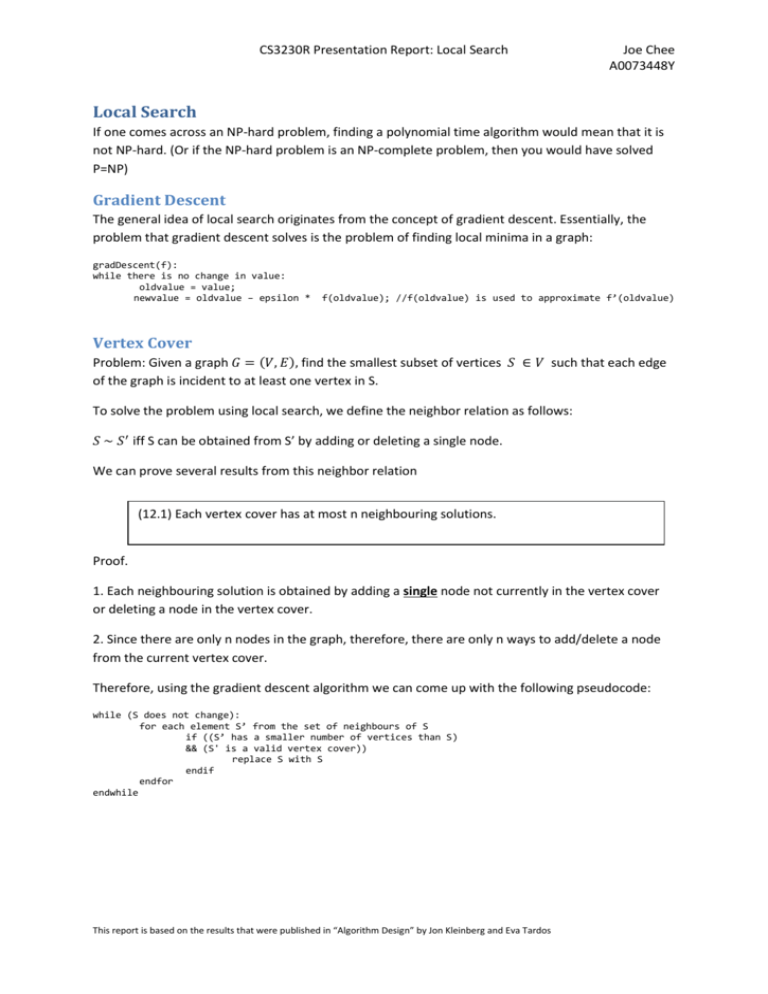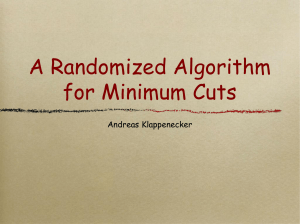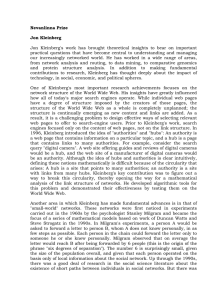Local Search
advertisement

CS3230R Presentation Report: Local Search
Joe Chee
A0073448Y
Local Search
If one comes across an NP-hard problem, finding a polynomial time algorithm would mean that it is
not NP-hard. (Or if the NP-hard problem is an NP-complete problem, then you would have solved
P=NP)
Gradient Descent
The general idea of local search originates from the concept of gradient descent. Essentially, the
problem that gradient descent solves is the problem of finding local minima in a graph:
gradDescent(f):
while there is no change in value:
oldvalue = value;
newvalue = oldvalue – epsilon *
f(oldvalue); //f(oldvalue) is used to approximate f’(oldvalue)
Vertex Cover
Problem: Given a graph 𝐺 = (𝑉, 𝐸), find the smallest subset of vertices 𝑆 ∈ 𝑉 such that each edge
of the graph is incident to at least one vertex in S.
To solve the problem using local search, we define the neighbor relation as follows:
𝑆 ~ 𝑆 ′ iff S can be obtained from S’ by adding or deleting a single node.
We can prove several results from this neighbor relation
(12.1) Each vertex cover has at most n neighbouring solutions.
Proof.
1. Each neighbouring solution is obtained by adding a single node not currently in the vertex cover
or deleting a node in the vertex cover.
2. Since there are only n nodes in the graph, therefore, there are only n ways to add/delete a node
from the current vertex cover.
Therefore, using the gradient descent algorithm we can come up with the following pseudocode:
while (S does not change):
for each element S’ from the set of neighbours of S
if ((S’ has a smaller number of vertices than S)
&& (S' is a valid vertex cover))
replace S with S
endif
endfor
endwhile
This report is based on the results that were published in “Algorithm Design” by Jon Kleinberg and Eva Tardos
CS3230R Presentation Report: Local Search
Joe Chee
A0073448Y
However, this may not give us the global minima at times, for example, take the star graph, and it’s
two valid termination points for the algorithm below:
Figure 1: Original Star
Graph
Figure 2: Local Minima
Figure 3: Global Minima
As can be seen, the algorithm can terminate at local minimas that are very far away from the global
minima, and thus it is useful to think about the entire set of solutions as a landscape of solutions. Is
there any result that we can prove about the set of local minima?
The Metropolis Algorithm and Simulated Annealing
Metropolis algorithm
The Metropolis Algorithm is an attempt to improve the simplified idea of gradient descent by
simulating the behaviour of a physical system using principles of statistical mechanics.
Essentially, the probability of finding a physical system in a state with energy E is proportional to the
Gibbs-Boltzmann function: 𝑒 −𝐸/(𝑘𝑇) , where T > 0 is the temperature and k > 0 is a constant.
At all times, the simulation maintains a current state of the system and tries to produce a new state
by applying a perturbation to this state. We’ll assume that we’re only interested in states of the
system that are “reachable” from some fixed initial state by a sequence of small perturbations, and
we’ll assume that there is only a finite set of these states.
Let E(S) and E(S’) denote the energies of S and S’. If E(S’) <= E(S), then we update the current state to
be S’
(12.2) Let
𝑍 = ∑𝑒 −𝐸(𝑆)/(𝑘𝑇)
be the partition function. For a state S, let fS(t) denote the fraction of the first t steps in which the state
of the simulation is in S. Then the limit of f+s+(t) as t approaches infinity is, with probability approaching
1, equal to
1 −𝐸(𝑆)/(𝑘𝑇)
𝑒
.
𝑍
The proof is omitted as it will involve concepts in physics which will be a digression to the current
topic.
The metropolis algorithm can now be introduced as follows:
Start with an initial solution So, and constants k and T
In one step:
Let S be the current solution
Let S’ be chosen uniformly at random from the neighbors of S
If c(S’) <= c(S) then
Update S <- S’
Else
This report is based on the results that were published in “Algorithm Design” by Jon Kleinberg and Eva Tardos
CS3230R Presentation Report: Local Search
Joe Chee
A0073448Y
With probability e-(c(s’)-c(s))/(l~T)
Update S <- S’
Otherwise
Leave S unchanged
EndIf
Simulated Annealing
However, if T is large, the proability of accepting an uphill move is large, but if T is small, uphill
moves are almost never accepted. Therefore, we try to cool the algorithm as it progresses such that
it stabilises at a certain point.
Hopfield Neural Networks
A Hopfield network can be viewed as an undirected graph G = (V, E), with an integer-valued weight
we on each edge e; each weight may be positive or negative. A configuration S of the network is an
assignment of the value -1 or +1 to each node u.
If u is joined to v by an edge of negative weight, then u and v want to have the same state, while if u
is joined to v by an edge of positive weight, then u and v want to have opposite states. The absolute
value will indicate the strength of this requirement.
We say that an edge e = (u,v) is good if the requirement it imposes is satisfied by the states of its two
endpoints: either 𝑤𝑒 < 0 and 𝑠𝑢 = 𝑠𝑣 or 𝑤𝑒 > 0 and 𝑠𝑢 ≠ 𝑠𝑣 . Otherwise we say e is bad.
Alternatively, an edge is good if 𝑤𝑒 𝑠𝑢 𝑠𝑣 < 0
A node u is satisfied if the total absolute weight of all good edges incident to u is at least as large as
the total absolute weight of all bad edges incident to u. We can write this as
∑ 𝑤𝑒 𝑠𝑢 𝑠𝑣 ≤ 0 − (1)
𝑒
With this, we can now prove that if a Hopfield Network was defined as a directed graph instead of
an undirected graph, a network need not have a stable configuration.
12.3 Every Hopfield network has a stable configuration, and such a
configuration can be found in time polynomial in n and 𝑊 = ∑|𝑤𝑒 |.
To prove 12.3, we will use the simple iterative procedure, called the State-Flipping Algorithm, to
search for a stable configuration.
While the current configuration is not stable
There must be an unsatisfied node
Choose an unsatisfied node U
Flip the state of u
Endwhile
This report is based on the results that were published in “Algorithm Design” by Jon Kleinberg and Eva Tardos
CS3230R Presentation Report: Local Search
Joe Chee
A0073448Y
Clearly, if the state-flipping algorithm always terminates, then we will always have stable
configurations.
So therefore we will attempt to prove that the state-flipping algorithm always terminates, and the
key is to look for a measure of progress.
We define Φ(𝑆) to be the total absolute weight of all good edges in the network. That is,
Φ(𝑆) =
∑ |𝑤𝑒 | − (2)
𝑔𝑜𝑜𝑑 𝑒
When u flips its state, all good edges incident to u become bad, all bad edges become good )all other
edges remain the same) So, if we let 𝑔𝑢 and 𝑏𝑢 denote the total absolute weight on good and bad
edges incident to u, respectively, then we have
Φ(𝑆′) = Φ(𝑆) − 𝑔𝑢 + 𝑏𝑢
But since u was unsatisfied, from 1 we can conclude that 𝑏𝑢 > 𝑔𝑢 , and since they are both integers,
that means 𝑏𝑢 > 𝑔𝑢 + 1. Substituting this into equation 2 will give us
Φ(𝑆′) ≥ Φ(𝑆) + 1
Since from (2), we can see that the max value of Φ(𝑆) is W, therefore, there is a limit to the number
of iterations within the State-Flipping algorithm and thus the the State-Flipping algorithm will
eventually terminate and thus every Hopfield network has a stable configuration.
This report is based on the results that were published in “Algorithm Design” by Jon Kleinberg and Eva Tardos
CS3230R Presentation Report: Local Search
Joe Chee
A0073448Y
Maximum-Cut Approximation via local search
In the Maximum-Cut Problem, we are given an undirected graph G = (V,E) with a positive integer
weight 𝑤𝑒 on each edge e.
For a visual representation, essentially, a maximum-cut problem requires one to partition a graph
into sets A and B such that the weights of edges with one vertex in set A and one vertex in set B is
maximised (In the example above, these edges are denoted in red).
In this case we can define an objective function Φ(𝑆) = 𝑤(𝐴, 𝐵) and a single-flip neighbourhood –
partitions (A,B) and (A’, B’) are neighbouring solutions if (A’,B’) can be obtained from (A,B) by moving
a single node from one side of the paritition to the other.
(12.5) Let (A,B) be a partition that is a local optimum for Maximum Cut
under the single-flip neighbourhood. Let (A*, B*) be a globally optimal
1
2
partition. Then, 𝑤(𝐴, 𝐵) ≥ 𝑤(𝐴∗ , 𝐵∗ ).
Proof. Let 𝑊 = ∑𝑤𝑒 . For 2 nodes u and v, we use 𝑤𝑢𝑣 to denote 𝑤𝑒 when 𝑒 = (𝑢, 𝑣).
For all 𝑢 ∈ 𝐴, (since otherwise u should be moved over to the other side of the partition for the
partition to be locally optimal)
∑ 𝑤𝑢𝑣 ≤ ∑ 𝑤𝑢𝑣
𝑣∈𝐴
𝑣∈𝐵
By adding all of these inequalities for all ∈ 𝐴 , we get:
2 ∑ 𝑤𝑢𝑣 ≤
{𝑢,𝑣}⊆𝐴
∑ 𝑤𝑢𝑣 = 𝑤(𝐴, 𝐵)
𝑢∈𝐴,𝑣∈𝐵
Doing the same for set B gives us
2 ∑ 𝑤𝑢𝑣 ≤
{𝑢,𝑣}⊆𝐵
∑ 𝑤𝑢𝑣 = 𝑤(𝐴, 𝐵)
𝑢∈𝐴,𝑣∈𝐵
Adding them together and division by 2 gives us
This report is based on the results that were published in “Algorithm Design” by Jon Kleinberg and Eva Tardos
CS3230R Presentation Report: Local Search
Joe Chee
A0073448Y
∑ 𝑤𝑢𝑣 + ∑ 𝑤𝑢𝑣 ≤ 𝑤(𝐴, 𝐵)
{𝑢,𝑣}⊆𝐴
{𝑢,𝑣}⊆𝐵
Adding w(A,B) on both sides gives us
∑ 𝑤𝑢𝑣 + ∑ 𝑤𝑢𝑣 + 𝑤(𝐴, 𝐵) ≤ 2𝑤(𝐴, 𝐵)
{𝑢,𝑣}⊆𝐴
{𝑢,𝑣}⊆𝐵
Noticing that the left hand side of the equation gives us W (since ∑{𝑢,𝑣}⊆𝐴 𝑤𝑢𝑣 accounts for edges in
set A, ∑{𝑢,𝑣}⊆𝐵 𝑤𝑢𝑣 accounts for edges in set B, w(A,B) accounts for edges that cross between the
two sets), we can thus conclude
𝑊 ≤ 2𝑤(𝐴, 𝐵)
Since 𝑤(𝐴∗ , 𝐵∗ ) ≤ 𝑊, we can thus conclude that
𝑤(𝐴∗ , 𝐵∗ ) ≤ 2𝑤(𝐴, 𝐵)
1
𝑤(𝐴∗ , 𝐵∗ ) ≤ 𝑤(𝐴, 𝐵)
2
Therefore, the claim in 12.5 is true.
Let (A, B) be a partition with weight w(A,B). For a fixed 𝜖 > 0, we define a single node flip to be a big
improvement flip if it improves the cut value by at least
2𝜖
𝑤(𝐴, 𝐵)where
𝑛
n = |V|
We will now consider a version of the Single-Flip Algorithm when we accept big-improvement flips
and terminate once no such flip exists, even if the current partition is not a local optimum.
(12.6) Let (A,B) be a partition such that no big-improvement-flip is possible.
Let (A*, B*) be a globally optimal partition. Then (2 + 𝜖)𝑤(𝐴, 𝐵) ≥ 𝑤(𝐴∗ , 𝐵∗ ).
(The proof for this is similar to that of 12.5, but we should add the term
2𝜖
𝑤(𝐴, 𝐵)
𝑛
to each
inequality. The first line ∑𝑣∈𝐴 𝑤𝑢𝑣 ≤ ∑𝑣∈𝐵 𝑤𝑢𝑣 should be replaced with ∑𝑣∈𝐴 𝑤𝑢𝑣 ≤
∑𝑣∈𝐵 𝑤𝑢𝑣 +
2𝜖
𝑤(𝐴, 𝐵))
𝑛
This report is based on the results that were published in “Algorithm Design” by Jon Kleinberg and Eva Tardos
CS3230R Presentation Report: Local Search
Joe Chee
A0073448Y
(12.7) The version of the Single-Flip Algorithm that only accepts big𝑛
improvement-flips terminates after at most 𝑂( 𝑒 𝑙𝑜𝑔𝑊) flips, assuming the
weights are integral, and 𝑊 = ∑𝑒 𝑤𝑒
Proof.
𝑒
1. Each flip improves objective function by at least a factor of (1 + 𝑛).
1 𝑥
2. (1 + 𝑥) ≥ 2 for all 𝑥 ≥ 1
1
𝑛/𝜖
3. From 2, (1 + 𝜖/𝑛)
≥2
𝑛
𝜖
4. From 1 and 3, objective function increases by a factor of at least 2 every flips.
5. Since weight cannot exceed W, weight can be doubled at most log W times, therefore the order of
𝑛
𝜖
time must be proportional to 𝑙𝑜𝑔𝑊
Choosing a Neighbor Relation
The neighbourhood of a solution should be rich enough that we do not tend to get stuck in bad local
optima, but if it is too large, then we have to iterate through too many sets of neighbours and thus
this might make the local search inefficient.
This report is based on the results that were published in “Algorithm Design” by Jon Kleinberg and Eva Tardos
CS3230R Presentation Report: Local Search
Joe Chee
A0073448Y
Best response dynamics and Nash equilibria
The problem: In a network like the Internet, one frequently encounters situations in which a number
of nodes all want to establish a connection to a single source node s. For example, the source s may
be generating some kind of data stream that all the given nodes want to receive, as in a style of oneto-many network communication known as a multicast. We will model this situation by representing
the underlying network as a directed graph G = (V,E), with a cost 𝑐𝑒 ≥ 0 on each edge.
Designated source node 𝑠 ∈ 𝑉 and a collection of k distinct terminal nodes 𝑡1 , 𝑡2 , 𝑡3 … , 𝑡𝑘 ∈ 𝑉 Each
agent 𝑡𝑗 wants to construct a path 𝑃𝑗 from s to 𝑡𝑗 using as little total cost as possible.
However, the key difference in this problem is that when more than 1 agent uses the same edge on
the path, the agents can then share the cost of the edge.
In the above example, let’s assume that all the agents t1 to t3 use the 1 + 𝜖 path to get from s to ti.
Each agent would then pay
1+𝜖
3
for using that edge. However, in this example, t3 realises that it can
minimize its own cost by using the 1/3 cost edge instead, and thus moves to that edge, and now
agents t1 and t2 are paying
1+𝜖
2
for the edge. The same reasoning can be applied for both agents t2
and t1 such that they switch to their respective edges. This then becomes a Nash equilibrium as
agents have now minimised their cost.
This example then shows that even though the social optimum was for all the agents to share the
1 + 𝜖 edge, as the agents only seek to minimize their own edges, this social optimum is never
reached.
Is there a Nash equilibrium in all instances?
From the above example, when one of the agents switched to the path with his own edge, it actually
increased the total cost within the system by 1 + 𝜖. Therefore, there must be some measure to
offset this increased cost.
A reasonable measure would be to define this additional measure as some sort of potential such
that the potential will decrease by ce/(x+1) when the first one stops using e, since for the agent to
view the move as a move that minimizes its cost, cf < ce/(x+1).
Therefore, a reasonable measure to use as the objective function can then be defined as the sum of
the changes in potential when an agent starts using an edge.
This report is based on the results that were published in “Algorithm Design” by Jon Kleinberg and Eva Tardos
CS3230R Presentation Report: Local Search
Joe Chee
A0073448Y
Φ(𝑃1 , 𝑃2 , … , 𝑃𝑘 ) = ∑ 𝑐𝑒 𝐻(𝑥𝑒 )
𝑒∈𝐸
Where the harmonic function H(xe) is defined as:
1
1
1
𝐻(𝑥𝑒 ) = 𝑐𝑒 (𝑥 + 𝑥−1 = ⋯ + 2 + 1)
12.14 Supposed that the current set of paths is 𝑃1 , 𝑃2 , … , 𝑃𝑘 , and agent tj updates its path
from Pj to P’j. Then the new potential Φ(𝑃1 , … , 𝑃𝑗−1 , 𝑃𝑗′ , 𝑃𝑗+1 , … , 𝑃𝑘 ) is strictly less than the
old potential Φ(𝑃1 , … , 𝑃𝑗−1 , 𝑃𝑗 , 𝑃𝑗+1 , … , 𝑃𝑘 )
Proof.
When tj was using path Pj, it paid 𝑐𝑒 /𝑥𝑒 for each edge in Pj. – (1)
After the switch, the cost only changes in the edges in 𝑃𝑗 − 𝑃𝑗′ and 𝑃𝑗′ − 𝑃𝑗 .
For each edge 𝑓 ∈ 𝑃𝑗′ − 𝑃𝑗 , it pays 𝑐𝑓 /(𝑥𝑓 + 1) as there is now 𝑥𝑓 + 1 agents on edge f. – (2)
Therefore, from (1) and (2), and the fact that tj viewed the switch as an improvement shows that
∑
𝑓∈𝑃𝑗′ −𝑃𝑗
𝑐𝑓
<
𝑥𝑓 + 1
∑
𝑐𝑓
− (3)
𝑥
′ 𝑒
𝑓∈𝑃𝑗 −𝑃𝑗
The potential change for 𝑃𝑗′ − 𝑃𝑗 is
∑
𝑐𝑓 [𝐻(𝑥𝑓 + 1) − 𝐻(𝑥𝑓 )] =
𝑓∈𝑃𝑗′ − 𝑃𝑗
∑
𝑓∈𝑃𝑗′ −𝑃𝑗
𝑐𝑓
− (4)
𝑥𝑓 + 1
The potential change for 𝑃𝑗 − 𝑃𝑗′ is
−
𝑐𝑒 [𝐻(𝑥𝑒 ) − 𝐻(𝑥𝑒 − 1)] = − ∑
∑
𝑒∈𝑃𝑗′ − 𝑃𝑗
𝑐𝑓
− (5)
𝑥
𝑒
′
𝑓∈𝑃𝑗 −𝑃𝑗
Summing the equations (4) and (5) together gives us, which is less than 0, by (3)
ΔΦ =
∑
𝑐𝑓 [𝐻(𝑥𝑓 + 1) − 𝐻(𝑥𝑓 )] −
𝑓∈𝑃𝑗′ − 𝑃𝑗
=
∑
𝑓∈𝑃𝑗′ −𝑃𝑗
𝑐𝑓
−
𝑥𝑓 + 1
∑
𝑐𝑒 [𝐻(𝑥𝑒 ) − 𝐻(𝑥𝑒 − 1)]
𝑒∈𝑃𝑗′ − 𝑃𝑗
∑
𝑐𝑓
<0
𝑥
′ 𝑒
𝑓∈𝑃𝑗 −𝑃𝑗
The potential decreases at each step along the path, and that each path has a unique potential, thus
paths are never revisited.
Since there are only finitely many ways to choose a path for each agent tj, and that best-response
dynamics can never revisit a set of paths again, we have also shown the following.
(12.15) Best-response dynamics always leads to a set of paths that forms a Nash
equilibrium solution.
This report is based on the results that were published in “Algorithm Design” by Jon Kleinberg and Eva Tardos
CS3230R Presentation Report: Local Search
Joe Chee
A0073448Y
Bounding the price of stability
We can also bound the price of stability by defining 𝐶(𝑃1 , … , 𝑃𝑘 )to be the total cost to all agents
when the selected paths are (𝑃1 , … , 𝑃𝑘 ).
12.16 For any set of paths P1,…,Pk, we have
𝐶(𝑃1 , … , 𝑃𝑘 ) ≤ Φ(𝑃1 , … , 𝑃𝑘 ) ≤ 𝐻(𝑘)𝐶(𝑃1 , … , 𝑃𝑘 )
Define E+ to be the set of all edges that belong to at least one of the paths P1,...,Pk. Then by the
definition of C, we have 𝐶(𝑃1 , … , 𝑃𝑘 ) = ∑𝑒∈𝐸 + 𝑐𝑒
Since 𝑥𝑒 ≤ 𝑘 for all e,
𝐶(𝑃1 , … , 𝑃𝑘 ) = ∑ 𝑐𝑒 ≤ ∑ 𝑐𝑒 𝐻(𝑥𝑒 ) = Φ (𝑃1 , … , 𝑃𝑘 ) − (1)
𝑒∈𝐸 +
𝑒∈𝐸 +
Also,
Φ (𝑃1 , … , 𝑃𝑘 ) = ∑ 𝑐𝑒 𝐻(𝑥𝑒 ) ≤ ∑ 𝑐𝑒 𝐻(𝑘) = 𝐻(𝑘)𝐶(𝑃1 , … , 𝑃𝑘 ) − (2)
𝑒∈𝐸 +
𝑒∈𝐸 +
Therefore, from (1) and (2),
𝐶(𝑃1 , … , 𝑃𝑘 ) ≤ Φ(𝑃1 , … , 𝑃𝑘 ) ≤ 𝐻(𝑘)𝐶(𝑃1 , … , 𝑃𝑘 )
(12.17) In every instance, there exists a Nash equilibrium solution for which the total
cost to all agents exceeds that of the social optimum by at most a factor of H(k)
We can start by running best-response dynamics on the social optimum to get a Nash equilibrium.
Let 𝑃1 , … , 𝑃𝑘 define the paths for this Nash equilibrium and 𝑃1∗ , … , 𝑃𝑘∗ . For this Nash equilibrium,
Φ (𝑃1 , … , 𝑃𝑘 ) ≤ Φ (𝑃1∗ , … , 𝑃𝑘∗ ) − (1)
From (12.16),
𝐶(𝑃1 , … , 𝑃𝑘 ) ≤ Φ (𝑃1 , … , 𝑃𝑘 ) − (2)
and
Φ (𝑃1∗ , … , 𝑃𝑘∗ ) ≤ 𝐻(𝑘)𝐶 (𝑃1∗ , … , 𝑃𝑘∗ ) − (3)
Putting (1),(2),and(3) together,
𝐶(𝑃1 , … , 𝑃𝑘 ) ≤ Φ (𝑃1 , … , 𝑃𝑘 ) ≤ Φ (𝑃1∗ , … , 𝑃𝑘∗ ) ≤ 𝐻(𝑘)𝐶 (𝑃1∗ , … , 𝑃𝑘∗ )
This report is based on the results that were published in “Algorithm Design” by Jon Kleinberg and Eva Tardos
CS3230R Presentation Report: Local Search
Joe Chee
A0073448Y
Therefore
𝐶(𝑃1 , … , 𝑃𝑘 ) ≤ 𝐻(𝑘)𝐶 (𝑃1∗ , … , 𝑃𝑘∗ )
And this Nash equilibrium has a cost that is within H(k) of the optimal solution, and we have thus
successfully bounded the price of stability.
This report is based on the results that were published in “Algorithm Design” by Jon Kleinberg and Eva Tardos










